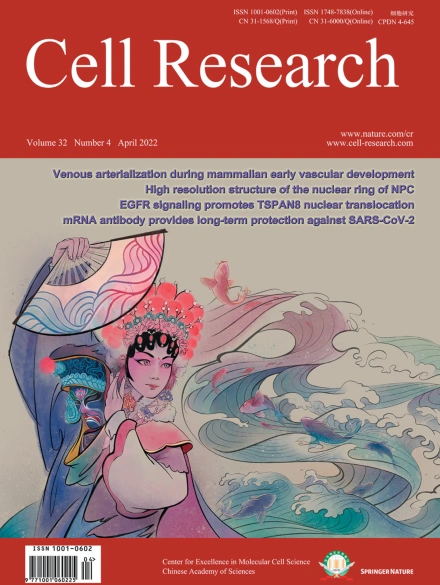
Advanced Search
Submit Manuscript
Advanced Search
Submit Manuscript
Volume 32, No 4, Apr 2022
ISSN: 1001-0602
EISSN: 1748-7838 2018
impact factor 17.848*
(Clarivate Analytics, 2019)
Volume 32 Issue 4, April 2022: 359-374
EGFR signaling promotes nuclear translocation of plasma membrane protein TSPAN8 to enhance tumor progression via STAT3-mediated transcription
Xiaoqing Lu1,2,† , Liwei An3,† , Guangjian Fan1,4,† , Lijuan Zang5,† , Weiyi Huang1 , Junjian Li1 , Jun Liu1 , Weiyu Ge1 , Yuwei Huang6 , Jingxuan Xu1 , Shaoqian Du1 , Yuan Cao1 , Tianhao Zhou1 , Huijing Yin1 , Li Yu6 , Shi Jiao7 , Hongxia Wang1,*
1State Key Laboratory of Oncogenes and Related Genes, Department of Oncology, Shanghai General Hospital, Shanghai Jiao Tong University School of Medicine, Shanghai, ChinaTSPAN family of proteins are generally considered to assemble as multimeric complexes on the plasma membrane. Our previous work uncovered that TSPAN8 can translocate into the nucleus as a membrane-free form, a process that requires TSPAN8 palmitoylation and association with cholesterol to promote its extraction from the plasma membrane and subsequent binding with 14-3-3θ and importin-β. However, what upstream signal(s) regulate(s) the nuclear translocation of TSPAN8, the potential function of TSPAN8 in the nucleus, and the underlying molecular mechanisms all remain unclear. Here, we demonstrate that, epidermal growth factor receptor (EGFR) signaling induces TSPAN8 nuclear translocation by activating the kinase AKT, which in turn directly phosphorylates TSPAN8 at Ser129, an event essential for its binding with 14-3-3θ and importin ß1. In the nucleus, phosphorylated TSPAN8 interacts with STAT3 to enhance its chromatin occupancy and therefore regulates transcription of downstream cancer-promoting genes, such as MYC, BCL2, MMP9, etc. The EGFR–AKT–TSPAN8–STAT3 axis was found to be hyperactivated in multiple human cancers, and associated with aggressive phenotype and dismal prognosis. We further developed a humanized monoclonal antibody hT8Ab4 that specifically recognizes the large extracellular loop of TSPAN8 (TSPAN8-LEL), thus being able to block the extraction of TSPAN8 from the plasma membrane and consequently its nuclear localization. Importantly, both in vitro and in vivo studies demonstrated an antitumor effect of hT8Ab4. Collectively, we discovered an unconventional function of TSPAN8 and dissected the underlying molecular mechanisms, which not only showcase a new layer of biological complexity of traditional membrane proteins, but also shed light on TSPAN8 as a novel therapeutic target for refractory cancers.
https://doi.org/10.1038/s41422-022-00628-8